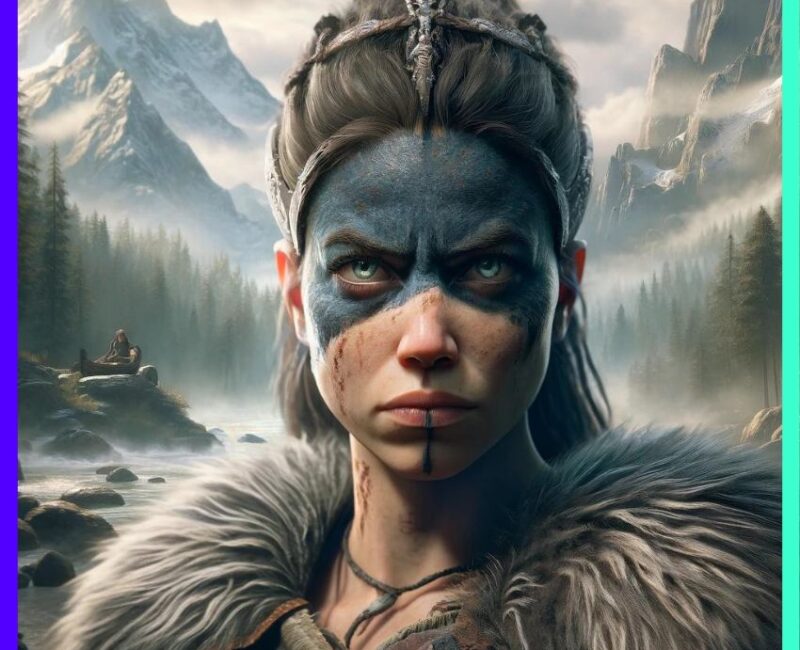Watching Senua emerge from a shipwreck, bruised and bloodied, immediately plunges players back into the depths of desperation and despair in Senua’s Saga: Hellblade II. The game opens with a taut, six-hour tour across the human realm of Midgard, marked by vivid action sequences, stunning Nordic-inspired locations, and intense encounters with terrifying foes. Hellblade II offers a satisfyingly brutal and consistently enthralling heroine’s journey, though its streamlined swordfighting emphasizes cinematic spectacle over deep gameplay mechanics.
Continuation of a Harrowing Journey
Although it’s been seven years since Hellblade: Senua’s Sacrifice, the events of Hellblade II follow closely after Senua’s initial vengeful trek to Helheim. This time, Senua feels empowered by her psychosis rather than burdened by it. A story recap is essential for those new to Senua’s tale. After the Icelandic slave ship she stows away on is wrecked in a severe storm, survivor’s guilt reignites her struggles with self-doubt, clashing with her stoic sense of justice. This sets her on another gripping path, battling both inner demons and the bloodthirsty monsters of Midgard, which take on human and mythical forms.
Companions on the Journey
Senua’s journey is marked by a few human companions, including a shackled slave master and a settler she rescues from a sacrificial altar. While these characters don’t get much screen time to develop deep personalities, their presence adds an organic method of exposition, contrasting with the superimposed live-action vignettes from the first game.
Senua: The Heart of the Story
The battle-scarred Senua, portrayed by Melina Juergens, returns in near-photorealistic form. Juergens’ performance is stirring, embodying a courageous and compassionate presence. Players are drawn into Senua’s determination to fight through fear and self-loathing, from moments of paralyzing anxiety to bursts of blood-boiling rage.
Expansive and Immersive Environments
Hellblade II takes Senua to dark, disturbing places, but the environments are more varied than the bleak backdrops of the original. Crawls through heinous pits of blood and gristle and infiltrations of marauder camps decorated with gruesome human bones are contrasted with peaceful mountain treks and stunning aurora borealis. The impressive lighting and fog effects add depth to each destination, grounding the journey even as it shifts between reality and Senua’s altered states. The visual design is so impressive that it justifies the 30 frames per second cap on Series X.
Exceptional Audio Design
The game’s visuals are complemented by first-class binaural audio design. Playing with headphones is essential to fully appreciate the detailed environmental sounds and the swirling voices in Senua’s head. These voices serve as the bickering angel and devil on her shoulders, adding confusion to every decision and sowing suspicion about supporting characters.
Brutal Combat in Midgard
In Hellblade II, Senua faces flesh-and-bone human warriors rather than just demonic manifestations. Every attack feels brutally real, with Senua’s sword splitting surface wounds that continue to bleed. The combat camera is tight, making every blow feel concussive. Dodging and timing parries are more critical, making each fight feel less predictable.
However, Hellblade II’s combat mechanics remain mostly unchanged from the original. While the game’s swift six-hour run time leaves little room for skill tree expansion or additional attack combos, the basic two-button mix of light and heavy sword slashes feels familiar. The combat has been further streamlined, with some abilities from the original dropped entirely.
One-on-One Combat Encounters
A notable improvement in Hellblade II is the limitation of duels to one-on-one encounters. This change prevents the player from being overwhelmed by offscreen enemies, a common issue in the original game. The energetic direction of these encounters makes each fight feel like a chaotic brawl rather than a choreographed sequence.
Engaging Environmental Puzzles
Hellblade II balances combat with environmental puzzles. These puzzles, which often involve aligning elements of the environment to form specific symbols, return from the original game. New elements like torchlit braziers and bubble switches add variety to these puzzles, transforming the terrain and opening new paths. While not overly taxing, these puzzles provide satisfying moments of cerebral engagement.
Linear Adventure with Hidden Secrets
Despite its wide-open appearance, Hellblade II is a linear adventure. Hidden lorestones and trees of Nordic knowledge offer additional lore without gameplay benefits but encourage exploration. A chapter select feature allows players to revisit and collect missed secrets without replaying the entire story.
Verdict
Senua’s Saga: Hellblade II is a spellbinding adventure, packed with cinematic spectacle and story surprises. It maintains a surging sense of forward momentum, never wasting a second of its run time. The combat, while mechanically simple, is consistently intimidating and immediate. The perspective-based puzzles, though familiar, are regularly engaging. With hardware-pushing visuals and absorbing audio, Hellblade II meets the high bar set by its predecessor, delivering a Viking-worthy feast for the senses.
For more detailed insights, visit the sources:




